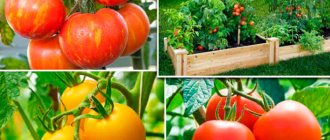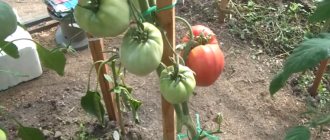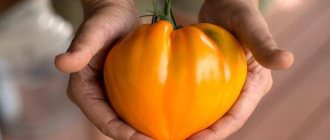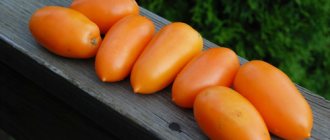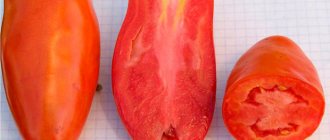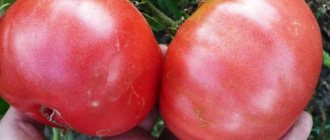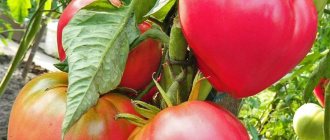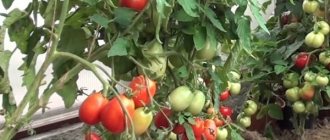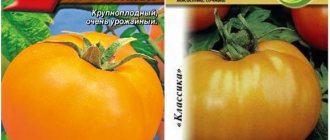Characteristics and description of the variety
Em Champion was bred by Siberian breeders and entered into the State Register of Breeding Achievements in 1982.
Determinate bush, height – no more than 70 cm, medium foliage, large leaves. Due to its low height, this variety can be grown in an apartment on the balcony. The first inflorescence is laid above the 5-7th leaf, the subsequent ones - every two leaves. 4-5 fruiting clusters are formed on one seedling.
The species is mid-season, 100-110 days pass from planting to full ripening.
It is highly resistant to the main diseases of the nightshade family, in particular, practically immune to fungal diseases.
The productivity is high, up to 7 kg of fruits are harvested from one plant, provided that four bushes are planted per 1 square meter. m.
The tomato is recommended for growing in open ground. In cold regions it is bred in protected structures.
Despite its small growth, the plant requires obligatory garter, otherwise the stem will not withstand the weight of ripe fruits. When grown in open beds, it does not require pinching.
The fruits are large, the average weight of one is 350-450 g. They have a crimson color, a round and slightly flattened shape (see photo). There are 4-5 seed chambers. The taste is excellent, harmoniously combining sugariness with sourness.
Vegetables are consumed fresh and used for preparing winter preparations (barrel pickles, marinades and canning).
Ripe tomatoes are not subject to long-term storage and do not retain their presentation during transportation. For this reason, the crop is not grown commercially.
Features of the fruit
The characteristics and description of the variety will allow you to decide how effective it is to grow the plant in your garden plot or on the balcony. And it’s worth starting with their size and weight. On average, one fruit weighs 400 grams. But there are facts when tomatoes reached a mass of 600 grams.
See also
Characteristics and description of the Honey Drop tomato variety, its cultivation and productivityRead
It is quite easy to distinguish EM Champion tomatoes from other varieties. The round and slightly flattened fruits have a crimson hue. One fruit contains 4 or 5 seed chambers. The amount of dry substances is 5%. It is recommended to immediately preserve or eat the collected tomatoes, as they are not suitable for transportation or storage.
Due to this drawback, farmers are not very fond of growing EM Champion tomatoes on their plots. Otherwise, all fruits are immediately sent for processing. It is worth noting here that this variety successfully combines acids and sugar. As a result, you can get delicious pastes and juices.
Fresh fruits are used to decorate the table and various dishes. For canning, it is better to use small tomatoes. As for large tomatoes, they can be pickled in a barrel or processed, resulting in a tasty juice or paste.
Advantages and disadvantages
The Em Champion variety has many positive qualities, thanks to which it is in great demand among gardeners:
- ease of care;
- high resistance to diseases;
- high fruiting rate;
- good adaptation to weather conditions in open ground;
- resistance to sudden temperature changes;
- does not require mandatory stepsoning;
- possibility of breeding on the balcony;
- good taste of fruits;
- large size vegetables;
- the ability to independently select seeds for the next planting.
Negative qualities include:
- short shelf life of ripe vegetables;
- need for garter;
- impossibility of growing the crop on an industrial scale.
Tomato variety EM-Champion
Novosibirsk breeder V.N. Dederko is well known to gardeners throughout Russia. He owns interesting varieties of tomatoes, including EM-Champion, which received high marks from tomato growers in Siberia and the Urals. The variety was registered in the State Register of Breeding Achievements of the Russian Federation in 2005, and received approval in all regions of the country. Recommended for open ground garden plots, household plots and small farms. Grows well in closed ground. It is not a hybrid, which means that self-collected seeds will show the same excellent results.
Description
The plant is determinate, standard type, up to 70 cm high, weak branching, moderate foliage. The leaf of the variety is of the usual type, medium size, light green, slightly wrinkled. The inflorescence is simple. The first fruit cluster is laid above the 5th leaf, the subsequent ones appear every 1 or 2 leaves. The brush often turns out to be multi-flowered, so not all ovaries ripen. In order for the EM Champion fruits to show their true weight, normalization is necessary. Pedicel with articulation.
The tomatoes are heart-shaped, smooth, dense, quite large - the originator claims a weight of 150 to 300 grams, maximum - up to 800 grams. The State Register indicates a slightly different weight - 126 - 134 grams. The skin is not thick, shiny. An unripe tomato is colored green, a ripened one becomes raspberry-pink (according to the State Register - red-orange). The pulp is very fleshy, juicy, elastic. The number of seed nests is 4 or more, they are small and have few seeds. The taste qualities are good for an early ripening species, but still reviews about the taste are contradictory.
Characteristics of the variety
- EM-Champion is a mid-early species, fruiting occurs on average 110 days after the appearance of full shoots;
- The yield of marketable fruits, according to the State Register, is 6.8 - 10 kg per 1 square meter. According to reviews from forum members, up to 7 kg can be removed from a bush, and 10 large-fruited tomatoes is already a whole bucket;
- the yield of ripe marketable fruits in the Novosibirsk region is 68%;
- Although the skin is thin, cracking of tomatoes is not a common occurrence;
- Tomato immunity is good; among the reviews, resistance to late blight is mentioned;
- transportability and keeping quality are not the strongest aspects of the variety;
- The method of consuming fruits is universal. First of all, of course, early tomatoes are good in salads. But the variety produces excellent quality tomato products, especially good tomato juice.
There are varieties on sale with similar names - Weight Champion, Champion (F1), Pink Champion (F1), Champion of Buryatia. They have nothing to do with the described variety; these are separate species not included in the State Register.
Agricultural technology
Sowing of seedlings is carried out 50 - 55 days before the intended planting in a greenhouse or 60 - 65 days in open ground. At the age of 2 true leaves, the seedlings dive. Plants can be planted densely - every 30 cm. It is recommended to form EM-Champion in 1, 2 or 3 stems. But it should be borne in mind that the more stems you leave, the greater the load on the bush, and as a result, the fruits will be smaller. To grow 800-gram specimens, you need to normalize the number of stems and ovaries. Be sure to tie it up so that the growing brushes do not overwhelm the bush. Particularly heavy brushes need to be supported. Agricultural technology is common for the crop as a whole. Watering is carried out as needed, the plant is responsive to fertilizing, you can use complex universal fertilizers.
EM-Champion is a productive and unpretentious variety, valued for its early harvest and fertility. There is no arguing about tastes, of course, especially since we are talking specifically about early tomatoes. Many of those tomato growers who first grew this variety decided not to abandon it in the future.
Features of planting and care
Sowing begins 60 days before planting seedlings in open ground. The final dates are determined in accordance with the climatic characteristics of the region.
Both common wooden boxes and individual plastic glasses or peat pots serve as planting containers. Small holes are made at the bottom of the containers so that excess moisture does not remain trapped during watering.
The containers are filled with nutritious soil, which is prepared from a mixture of garden soil with peat and humus in equal parts. The prepared soil is scalded with boiling water or watered with a dark-colored manganese solution - this way pathogenic flora is destroyed.
Before sowing, the seeds are disinfected in a weak solution of potassium permanganate and treated with a growth stimulant to improve germination.
The seed is laid to a depth of 1.5 cm and compacted well on top.
Reference. When planted shallowly, most seeds germinate along with the seed coat, which noticeably slows down their further growth.
After planting, the containers are covered with film and left indoors at a temperature of at least 23°C. At the first shoots, the planting containers are moved to a more illuminated place, but not in direct sunlight.
Water lightly without over-moistening the soil. After each watering, loosen the soil with a fork or wooden stick.
When two true leaves appear, the seedlings dive, planting them in separate containers. The day before picking, the sprouts are watered for easier removal from containers without damaging the root system.
Two weeks before transplanting into open ground, young bushes begin to harden. To do this, they are taken out into the open air for 2-3 hours. The night temperature in the room is reduced to 13°C. Gradually, the time spent on the street is increased to 18 hours.
Growing in open ground
After 60 days, the seedlings are ready for transplanting. The best option for seedlings is loamy soil, therefore, if there is a lot of clay in the soil, you need to add river sand or peat in the amount of 3-4 buckets per 1 square meter to make it lighter. m. Compost is added as fertilizer (two buckets per 1 sq. m).
Planting pattern: 40 cm – distance between seedlings, 50 cm – between rows. Superphosphate and ash are added to each well.
It is best to replant in cloudy weather or in the evening. After transplanting, the beds are moderately watered with warm, settled water at the root of the plant.
Regular watering is established as young bushes take root. Water no more than twice a week, with the exception of hot days, when the number of waterings is increased to 3-4 times.
After watering, the beds are loosened and mulched. These procedures not only have a beneficial effect on the development of seedlings, but also serve as preventive measures in the fight against pests.
The plant is fed three times a season with complex fertilizers or organic matter. A product made from nettles and dandelions, which is infused in the sun for 10 days, is well suited as an organic product. Before watering, the infusion is diluted in a ratio of 1:10.
Reference. Organic fertilizers must be diluted in a large ratio, otherwise the root system may burn.
Despite its small growth, the crop requires obligatory garter. To do this, wooden stakes or a metal support are installed next to each bush. As they grow, they are fixed to supports and branches, since they cannot support the weight of ripe fruits.
The Em Champion tomato does not require mandatory pinching. Stepchildren are removed only initially, until the first fruiting cluster is formed.
Harvest and use of vegetables
This tomato has established itself as a high-yielding crop. One small plant produces up to five fruiting clusters, each of which develops up to six weighty fruits. Consequently, up to 7 kg of vegetables are obtained from one plant, and from 1 sq. m – up to 28 kg of excellent tomatoes.
The only negative is the short-term storage of ripe vegetables. When collected en masse, they are immediately canned or processed. It is for this reason that farmers do not like to grow the Em Champion variety.
Thanks to the amazing taste of tomatoes, which harmoniously combines sweetness and sourness, vegetables make excellent juices and pastes. This is an indispensable basis for hot and vegetable dishes and various sauces.
Tomatoes do not lose their taste in pickles and marinades; they combine well and complement any other variety in winter preparations.
Growing tomatoes
Although the bush is small in size, it needs a garter. This also applies to the branch. They prop up because the fruits are large in size and weight. If the plant is grown in unprotected soil, then there is no need to trim the stepsons.
In the case of planting a tomato on a balcony, the bush must be formed from one or two stems. This will prevent its growth. It is recommended to use complex fertilizers for fertilizing.
In the south of the country, tomatoes can be safely grown in unprotected soil. As for the northern regions, it is better to plant plants in greenhouses. This will ensure high yield of the variety.
Before planting, the seeds of the variety are soaked in a growth stimulator. This allows you to significantly speed up their germination. Thus, the seeds can be planted in pots within a few days. Until they germinate, the containers must be kept in a warm place. For irrigation, it is recommended to use warm water with the addition of a small amount of fertilizer.
See also
Description and yield of the Bokele tomato variety, reviews from gardenersRead
For growing in open ground, it is recommended to use seedlings. This will ensure high yields. It is worth noting here that improper sowing of seeds in unprotected soil increases the risk of their failure to germinate. As a result, crop yields are at risk.
Diseases and pests: control methods and prevention
Despite the high resistance of the crop to diseases of the nightshade family, tomato is still susceptible to bacterial black spot and blossom end rot. These are fungal diseases, the pathogens of which successfully reproduce at high humidity and air temperature.
Prevention against them includes monitoring moisture in the beds, timely loosening the soil and removing weeds with roots. For treatment, use a calcium nitrate solution by spraying diseased plants. The drug “Fitolavin” helps against bacterial spotting.
To protect the crop from attacks by insect pests (whiteflies, mole crickets, slugs, cutworms), plants are sprayed with infusions of fragrant herbs once a week. It is also good to plant sharp-smelling herbs next to tomatoes.
Crushed cloves of garlic and fish heads buried in the beds help against pests. The Colorado potato beetle and slugs are collected by hand, and the soap solution used to treat the stems saves from aphids.
Among the industrial insecticides, the preparations “Zubr” and “Lepidotsid” are used. But do not forget that chemical treatment is possible only until the first ovaries.
Reference. Tomatoes grown on balconies, as a rule, do not get sick and are not attacked by parasitic insects.
Caring for tomatoes in open ground
Watering
Tomatoes prefer high soil moisture near the roots up to 85% and air humidity up to 60%. It is necessary to ensure regular watering every 3–5 days, up to 5 liters of water per bush. During fruiting, reduce the amount of watering to once every 5–7 days. Water in the morning or evening at the root. Use water pH 6–6.5, heated to +16–18 °C.
If you water more often, the fruits will not be sugary. Excessive watering will increase the humidity in tomato plantings and promote the appearance of fungal diseases. With irregular watering, the fruits will begin to crack. A sign of insufficient watering is that the leaves wither and the buds fall off. A lack of moisture will lead to poor fruiting, the fruits will become small and will not correspond to the varietal characteristics.
When deciding to grow tomatoes every year, it is advisable to purchase a hygrometer - a device for determining air humidity.
Feeding with fertilizers
Why do tomatoes need macro- and microelements:
- activate growth, flowering and fruiting;
- reduce the number of barren flowers;
- improve the synthesis of proteins, carbohydrates and vitamins in fruits;
- the plant becomes resistant to changes in air temperature and gets sick less.
What fertilizers to use:
- During the period of seedling growth, choose fertilizers with nitrogen for the growth of green mass. Use ammonium nitrate and urea once every 2–3 weeks.
- During flowering and fruit formation, use potassium-phosphorus preparations every three weeks. It is recommended to use potassium monophosphate, diammophos.
- Spray plants to add trace elements of boron, zinc, magnesium, and calcium. Preparations such as “Boric acid” and “Reacom for tomatoes” promote pollination and fruit growth and increase yield.
Formation of a bush - pinching
The plant develops shoots on the sides of the main stem - stepsons, from which extra stems grow. It is recommended to remove these shoots and pinch out the top growth point of the bush in July.
Why stepchildren:
- accelerate the growth of tomatoes and increase yield;
- direct the nutrients accumulated by the seedling to the growth and ripening of fruits;
- avoid dense plantings when there is a risk of spreading fungal diseases.
How to stepchild:
- start pinching 20 days after planting the seedlings in the ground;
- once every 5–8 days, pluck no more than two to three shoots at a time from one bush;
- do not allow shoots to grow excessively; if they are 4–7 cm long, remove them;
- leave a “stump” of half a centimeter; it will not allow a new shoot to appear quickly;
- use disinfected pruners or scissors;
- work during the daytime, during which time the wound at the cut site will quickly dry out.
Bush formation options:
Bushes of tall varieties of tomatoes form one stem. Such plants form flower clusters up to the very top of the shoot, so you can remove all lateral shoots without reducing the yield.
Medium-sized varieties grow in two stems. One of the most powerful sprouts is left on the bush, and the rest are removed.
Low-growing varieties are grown in three stems. The two best side shoots are left on the bush.
How to tie tomatoes
Tall bushes with long shoots and short bushes with large fruits need a garter.
Why tie it:
- watering at the root is simplified, water does not fall on the fruit;
- tomatoes from the lower shoots are eaten by slugs and earthworms;
- the bush is better ventilated, the effectiveness of fungicides and insecticides increases;
- convenient to harvest without damaging the plant.
Do not use thin wire or fishing line. Use special reusable straps, which are sold in specialized stores. This material will last for many years. It is recommended to disinfect it every year before use.
Garter methods:
- A peg near each bush. It can be plastic, bamboo, wood.
- Trellis. Powerful stakes made of metal or wood are dug into the ground at a distance of several meters from each other. A wire is stretched across them at a distance of 30 cm.
- Hooks with fishing line. A method in which a rope is pulled over stakes. A fishing line with a plastic hook at the end is attached to this cable at a distance of 30 cm, to which the shoots of the plant are attached.
- Plastic arcs are dug in near each bush. The shoots are secured with garters in several places.
Reviews
Reviews from gardeners confirm the unpretentiousness of this variety of tomatoes in care. Minimal expenditure of effort and time leads to a rich harvest.
Inna, Tambov region: “Truly a champion! From one seedling I got a whole bucket of tomatoes. Very large vegetables, which is surprising for such bushes, and the taste is wonderful. I will definitely plant more!”
Valentin, Voronezh region: “My favorite tomato, I plant it every year. I really like it: the bushes are not tall, the tomatoes are fleshy and large, and most importantly - healthy throughout the season. I just water and feed them. I’m always happy with the result.”
Post-germination care for tomato seedlings
Every gardener wants his tomato seedlings to grow strong and healthy. For crops to germinate, a temperature of 23–25 degrees Celsius and moderate substrate humidity are required. The crops are ventilated daily by removing the glass (film).
Growing conditions for tomato seedlings significantly affect the development of seedlings. One of the conditions is sufficient illumination; tomato seedlings will not stretch. Early sowing, when there is not enough sunlight and there is no additional lighting, also leads to the elongation of seedlings.
Good seedlings grow if, after germination, they are moved to a cooler place. During the day, the optimal temperature is between 20 and 22 degrees, and at night, 18 degrees is enough.
Watering tomato seedlings.
There are two points here: watering from a spray bottle and at the root. Within 4 - 5 days after germination from a spray bottle, then only at the root. For watering it is convenient to use a small watering can or syringe.
Important: Maintain a balance when watering, do not allow overflow and dry soil. Excess water activates pathogenic microorganisms in the soil, dryness of the earthen clod leads to the death of the seedling
It is better to water tomato seedlings early in the morning so that the soil dries out by evening. This is a prevention against blackleg disease. The water should not be cold; it is better to take settled and warm water.
Feeding tomato seedlings.
For normal and successful development, plants need fertilizing; the gardener’s task is to take care of this. What to feed, organic matter or mineral fertilizers, everyone decides for himself.
The first feeding of tomato seedlings is approximately 10 days after planting in separate cups. The plants are already noticeably stronger; you can water them with a solution of Nitroammofoska, a mineral fertilizer. 0.5 cups of solution is poured onto one plant (0.5 tbsp of fertilizer is diluted in 5 liters of water).
You can spray Epin, a growth stimulator, on the leaves 3–4 days after picking. There is no need to feed the seedlings before picking; they have enough nutrition in the substrate.
The second feeding with the same solution after the first is in 10 - 12 days, the next one no earlier than a week later. Before planting seedlings in the ground, 4–5 days before, feed them well with superphosphate and wood ash. The solution is prepared at the rate of 1 tablespoon of each fertilizer per 10 liter bucket of water.
Feeding tomatoes with folk remedies.
Onion peel. Two handfuls of onion peels are poured into a liter jar and filled with hot water. After a day, strain and the solution is ready. You can water by replacing the water or from time to time.
Iodine. To spray tomato foliage, mix 1 drop of iodine and 0.5 cups of whey in 2 liters of warm water. One leaf subcortex is enough during seedling growth.
Picking tomato seedlings.
When the seedlings have 2-3 true leaves, you can start picking. Seedlings planted in a bowl will no longer have enough nutrients and will slow down their development. When picking, more developed and stronger seedlings are taken, weak ones are discarded.
I advise you to take tall, disposable cups for seedlings; seedlings grow best in them. At the bottom of one cup we make holes with a knife for drainage and insert it into another, whole. Through trial and error, I came up with this method of planting tomato seedlings (the choice is yours).
The scheme for planting seedlings in boxes or plastic containers is in a checkerboard pattern; this is a more optimal option. You can also plant seedlings in peat cups, the main thing is not to overdry the seedlings in them.
Tomato seedlings will more easily survive picking if the event is carried out in the evening. During the night without daylight, the seedlings adapt faster and will not be lethargic from transplanting. You need to plant the seedlings in moist, well-watered soil.
